Sometimes you can’t see the forest for the trees. Or in my case, the flowers for the vegetables. During my years as a small farmer, I was so focused on growing vegetables that flowers were an afterthought. I had a few sunflowers and nasturtiums here and there, a small patch of zinnias, and always a few sweetly unruly cosmos plants towering over the garden fence. But it wasn’t until my last year of market growing in 2018 that I deliberately planted several rows of zinnias as an experiment – hoping to grow enough to sell simple bunches at my farm stand.
That’s when I discovered how much I loved harvesting flowers: the daily ritual of heading out to the flower field with snips and a cool bucket of water before the heat of the day set in, the joy of seeing which blooms had opened, and which harbored a slumbering bumblebee or a dancing butterfly. Instead of morning yoga, I did my stretching by reaching into the dense patches of tall, tickly plants. Stripping the leaves off long stems and dropping them into buckets brought the immediate satisfaction of seeing a kaleidoscope of color at my feet.
In the years after I gave up market gardening, I returned to growing vegetables in a small home garden. But the flower bug had bitten. It wasn’t long before I was squeezing the tomatoes and beans into smaller and smaller spots to make space for sweet peas and snapdragons. I discovered that the perennial gardens I planted near our house could do double-duty, enhancing our landscape and yielding cut flowers, such as coneflowers and black-eyed Susans.

I began to try my hand at simple bouquets and rudimentary flower arrangements just for fun – to have around the house and to give away to friends. In search of inspiration and information, I started reading flower books in my spare time – beginning with Floret Farm’s Cut Flower Garden: Grow, Harvest & Arrange Stunning Seasonal Blooms (Chronicle Books, 2017) by Erin Benzakein. In fact, like thousands of aspiring flower folk, I found myself captivated by everything Benzakein offered. (Check out floretflowers.com to see what I mean.) I devoured her next two books, Floret Farm’s A Year in Flowers: Designing Gorgeous Arrangements for Every Season (Chronicle Books, 2020) and Floret Farm’s Discovering Dahlias: A Guide to Growing and Arranging Magnificent Blooms (Chronicle Books, 2021). Eventually, I signed up for her online intensive flower course. (You can take her mini-courses for free.)
Through Benzakein’s recommendations, I discovered British gardener Sarah Raven and bought her book, A Year Full of Flowers: Gardening for All Seasons (Bloomsbury Publishing, 2021), which is now seriously dog-eared. A friend on the Island told me about the incredible floral arranger and photographer Christin Geall and her gorgeous book, Cultivated: The Elements of Floral Style (Princeton Architectural Press, 2020).
Geall’s book taught me about color and shape – and opened up the world of plant varieties to me. From Geall and from Benzakein I finally learned a secret that had eluded me: fillers and foliage are the unsung heroes of any arrangement, turning a simple bunch of flowers into a bouquet.
Several years into my pursuit, I’m pretty much head-over-heels in love with every aspect of flower growing and arranging. And though I still have much to learn about arranging, I have managed to pull off a few blue ribbons at the Agricultural Fair. While my husband and I are now building a bigger garden (of course!) and even added a hoop house last year, I feel confident in telling you that you don’t need a ton of space. With a little strategy and a few tips, you can create a garden that brings you joy – and plenty of flowers to fill your house.
Select a Mix of Annuals, Perennials, Shrubs, Bulbs, Corms, and Tubers

While everyone knows and loves annual cutting flowers, such as zinnias, sunflowers, and cosmos, most folks don’t realize how valuable perennials are for bouquet material. Though they don’t flower for as long or as steadily as annuals, their foliage can be much more useful, and their diverse blooms offer shape and texture that lend a bouquet character and micro-seasonality. Think of what plants such as goldenrod, grasses, and black-eyed Susans do for fall arrangements, and how quintessentially springtime peonies and phlox are.
Don’t be afraid to experiment with cut flowers from bulbs, corms, and tubers, either. Consider planting more flowering shrubs, such as lilacs, hydrangeas, and roses, in your landscape. Even flowering fruit trees (think: cherry and crab apple) yield great material for arrangements. You’ll be amazed at how much more flexible and vibrant your flower arrangements will be if you think beyond annuals. (For a list of ideas, see the Favorite Cut Flowers sidebar below.)
That’s not to say that annuals shouldn’t be your biggest cut-flower priority. Because they bloom so prolifically (the more you pick them, the more they grow), they’ll give you the primary volume and color for your bouquets. To shake up your annual selection, start seeds indoors in the spring with a few simple supplies. (You’ll have to invest in grow lights, though; there’s no way around that.) By buying seeds instead of nursery seedlings, you’ll have a much wider choice of varieties to grow. Some of my favorite places to buy seeds include burpee.com, floretflowers.com, johnnyseeds.com, rareseeds.com, reneesgarden.com, selectseeds.com, and territorialseed.com.
Prepare Your Site
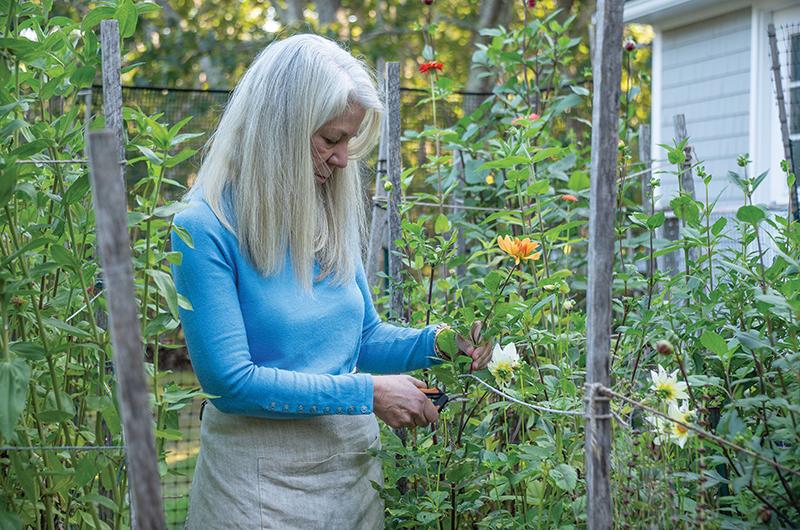
The conditions for growing annual cut flowers are quite similar to those for vegetables. Because they are tempting to deer – and they need regular irrigation – annual cutting flowers do best in an organized fenced garden, in a spot that gets plenty of sun, and that has a nearby water supply. That’s why my former vegetable garden is now mostly cut flowers!
Treat the beds to plenty of compost and incorporate organic flower fertilizer (such as Flower-tone) into the soil before planting. Plant your seedlings in rows (not circles or squares – don’t get decorative) so that you can lay irrigation hoses down straight and support the flowers by boxing them in with stakes and twine if needed. Some flowers, such as sweet peas and flowering vines, will need trellising. In general, you can plant seedlings closer together than you think; floretflowers.com has guidelines for spacing.
When plants are about to bloom, fertilize with a flower-specific fertilizer (such as FoxFarm’s Big Bloom). Don’t make the mistake of using a fertilizer high in nitrogen, as it will promote leaf growth over blooms.
When it comes to annuals, in most cases you’ll do yourself a favor by not weaving them into your perennial landscape or planting them next to your back door. The plants themselves are often not that attractive; they get leggy and can need staking. And as soon as the flowers bloom, you cut them! (Annual salvias are an exception to this rule.)
On the other hand, perennial plants that yield cut flowers are welcome in your landscape. Consider planting multiples of one type of plant for a big impact and lots of your favorite blooms. Perennials require far less watering than annuals once they’re established, especially if you choose drought-resistant plants, such as lavender, sedum, salvia, yarrow, and grasses. These plants also happen to be deer-resistant, so they’re perfect for the Vineyard perennial garden. They should still have a nearby water source, though, and you’ll need to be mindful of those that require full sun. You’ll find a great selection of perennials at our Island nurseries; shop and plant in spring before the heat arrives.
Grow Flowers That Bloom at Different Times of the Year
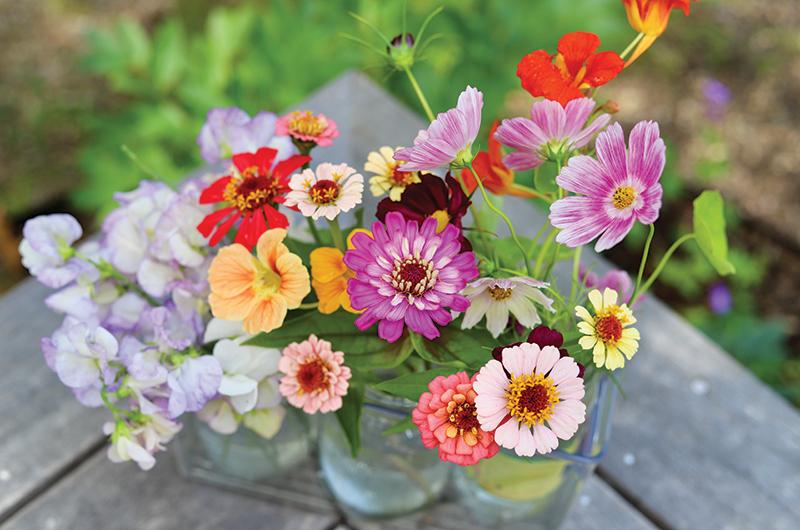
One of the great joys of growing your own cut flowers is that you can have fresh bouquets in your home throughout the growing season. By incorporating cold-hardy annuals, bulbs, perennials, shrubs, and flowering trees into your plan, you can start out the season with early (winter-blooming!) hellebores, move on to daffodils, tulips, lilacs, and peonies in the spring, blaze through the summer with annuals and colorful perennials, and wind up our beautiful long fall with dahlias, goldenrod, asters, and more. To help your planning, I’ve made a list of Cutting Flowers by Season on page 45 that indicates which flowers bloom at different times of the year.
Make Room in the Garden for Plenty of Fillers and Foliage
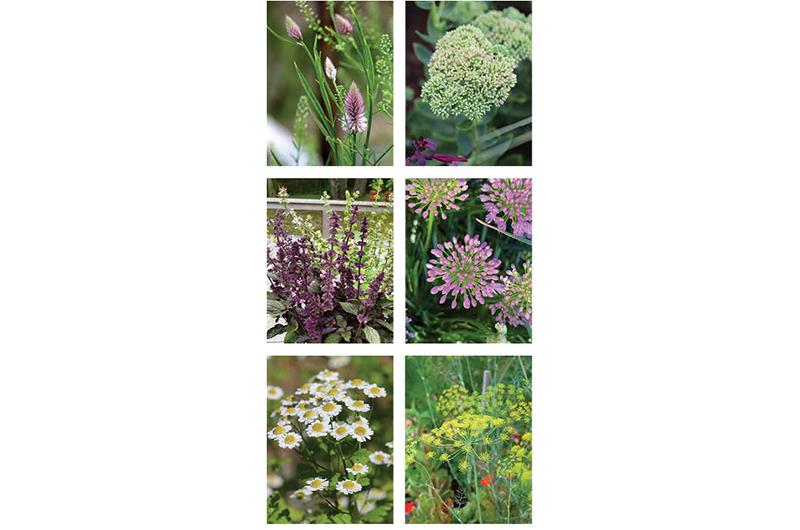
Bouquets and arrangements need a whole lot of supporting actors; the stars can’t pull off the show alone. You need a variety of shapes, a mix of textures, a range of colors, and, most important, a few of each of these things that all bloom or mature at the same time.
In terms of shape, consider flowers that have umbrella-shaped blooms (such as dill and Queen Anne’s lace), flowers that are tall and lanky (flowering basils), and flowers that are feathery (celosia). For a variety of blooming times, plant spring-flowering fillers (alliums), summer-blooming fillers (feverfew), and fall-blooming fillers (sedum).
Lastly, if you feel adventurous, you can find interesting textures for your bouquet by exploring your own property or those of willing neighbors for wild blueberry and honeysuckle foliage, wild yarrow, rose hips, and other textural fillers. As long as you harvest sustainably (never take more than a small portion of a plant), foraging is a lovely way to round out a bouquet.
Select a Color Palette or Two for Fun
Picking a color palette for your cut flowers – perhaps two complementary colors or three or four colors all in the same family – can help make seed and plant purchasing easier for you. And it will make you feel better when you start arranging flowers and see how the hues work together.
I love the complementary combination of lavender-blues and peachy-apricots and coral tones. But you can certainly plant more than one color palette, especially when you consider seasonality. You won’t want to be without burnt oranges and yolky yellows in the fall, bright raspberries and lime-greens in the summer, and pale pinks and white in the springtime.
Learn to Harvest Correctly
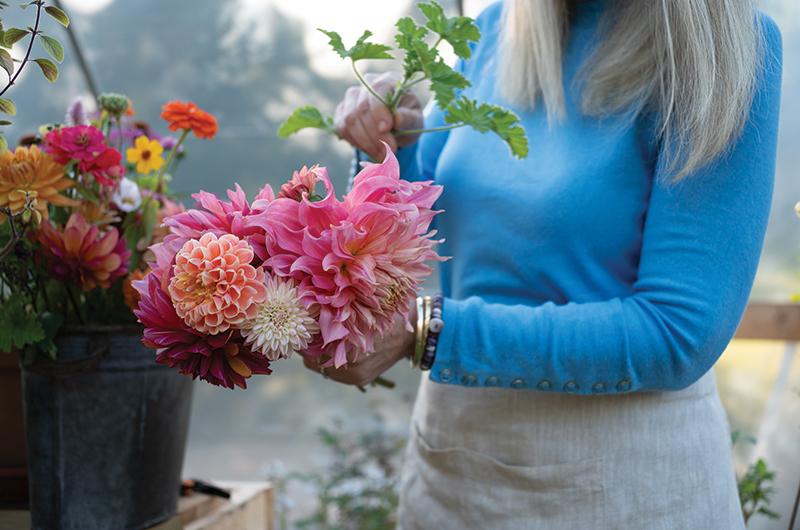
Given all the hard work you’ve put into growing your flowers, you want to ensure they have the longest vase life possible. How long your flowers last will depend, in part, on the type of flowers you grow – many of my top picks (see the Favorite Cut Flowers sidebar at right) are chosen with longevity in mind – but vase life also has to do with how and when you harvest your flowers. For the best chance at success, it’s essential to harvest in the early morning or the cool evening, when the stems are hydrated. In the heat of the day or in direct sunlight, the plants will send water back down to their roots to conserve, leaving stems prone to wilt if you pick them then.
When you head out to the garden, bring a pair of snips and a cool bucket of water that’s the right height and width to comfortably hold stems without crushing blooms. Cut deeply into annual plants – don’t worry that you’re sacrificing a few buds; this will encourage the plant to bloom more. You want the longest stems you can harvest for bouquets and larger flower arrangements. Strip all or most of the leaves off right there in the garden, as leaves will draw water away from blooms.
Once finished, bring the bucket(s) to a cool place (a basement or garage), recut the bottom of the stems, and let them rest in water overnight or for several hours before arranging. Dahlias, lilacs, hydrangeas, and roses benefit from a hot water dip before resting. Even better, crush the ends of woody stems, such as those found on lilacs and hydrangeas, with a hammer before soaking.
Finally, add flower food to fresh water before arranging if you like. You can mail order flower food or make your own by adding a teaspoon of sugar (for nutrition) and a few drops of bleach or vinegar (to prevent bacterial growth) to the vase water.
Master Arranging Basics
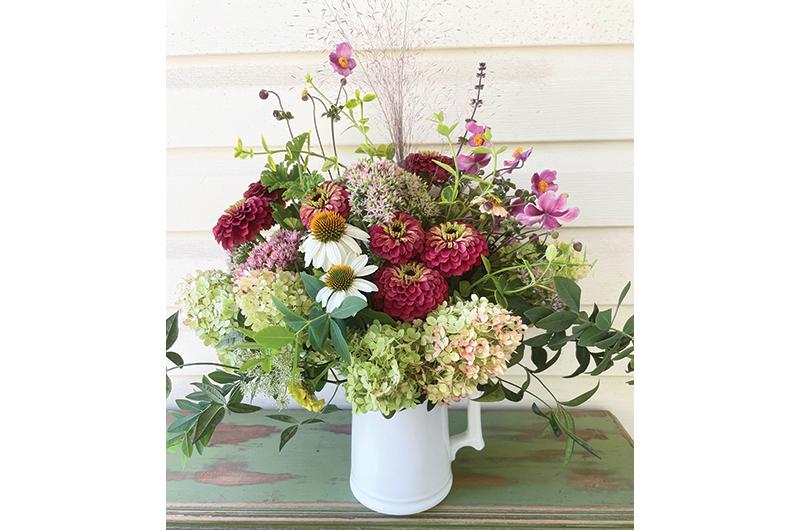
When you’re ready to arrange your flowers, choose a place you can spread out that’s near a water source. Have a bucket ready for snipped stems. Select a vase or other vessel that’s wider at the top than the bottom. For the most pleasing proportions in a flower arrangement, the flowers themselves should be twice as tall as the vessel. Use floral tape across the opening of the vase to make a grid, or add a ball of chicken wire to the vase to hold the stems in place.
Begin your arrangement with foliage (preferably types that drape and tumble a bit – nothing too stiff) around the outside edges of the container. Then arrange your focal flowers: start with just three or five or even one large one toward the center. Fill in with secondary flowers, foliage, and other fillers. Bunching three stems of one variety is also pleasing to the eye. Remember to turn your vessel around frequently if your arrangement is going to be viewed from 360 degrees; one that will sit up against a wall is a bit easier to pull off.
Don’t be discouraged if you don’t love your first efforts; flower arranging takes practice and your garden will give you lots of opportunity.
Favorite Cut Flowers
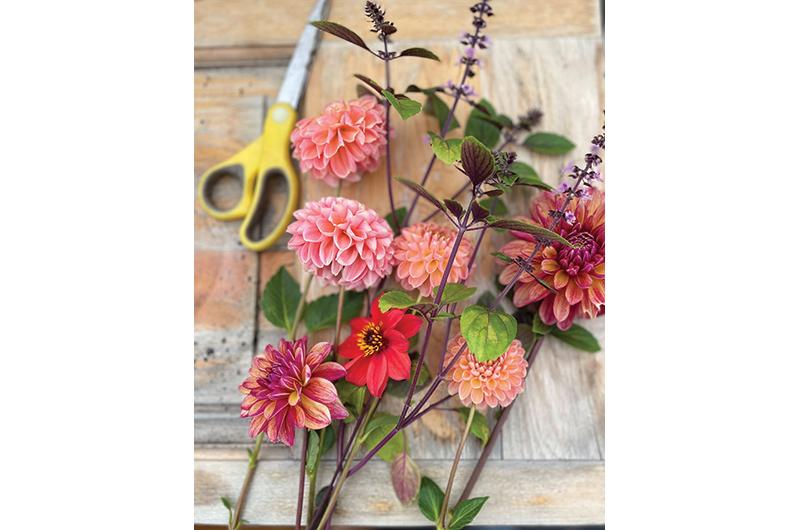
Every flower grower has an ever-changing list of their favorite varieties. And while choices can be highly personal – the color is appealing, or granny once grew it – the pros will also zero in on specific varieties that have long, sturdy stems, long-lasting and upright blooms, versatility in arrangements, and other strong qualities. Knowing what to look for in a specific type of flower is helpful; if you can’t find the exact variety you want, you can choose something with similar qualities.
Here you’ll find some specifics on a few popular cutting flowers, followed by a list of flowers I recommend growing by season below. It is by no means an exhaustive list. Visit library.floretflowers.com for more information.
Annuals
Zinnias: The Benary’s giant series offers large blooms in a range of colors, long stems, and good vase life. The coolest kid on the block right now is the two-toned queen zinnia, offered in a range of gorgeous limey-pinks, oranges, and yellows. The Oklahoma series make great filler flowers.
Cosmos: The extra-tall Versailles mix was bred specifically for cutting, and white purity is an outstanding flower. All the double click cosmos are fetching, and I’m very fond of two dwarf cosmos, rubenza (a dreamy faded cranberry color) and Xanthos (a creamy yellow).
Sunflowers: Choose branching varieties for the biggest yield of blooms. (I like autumn beauty and ring of fire). Check variety descriptions for mature height. If you don’t want sunflowers to drop pollen in your house, choose pollenless varieties. Direct seed sunflowers in the garden in full sun, and sow successive plantings to have blooms at different times.
Perennials, Bulbs, and Tubers
Peonies: These showstoppers bloom on the Island in both late spring and early summer, so choose a range of varieties to have a continuous bloom. Two of my favorites are Sarah Bernhardt (fully double pastel pink) and the sweet smelling festiva maxima (double white with touches of fuchsia).
Coneflowers: There are dozens of new hybrids of coneflowers available in all the colors of a Vineyard sunset (and then some!). I like the fiery corals and sunny yellows of the sombrero series, and the tall Magnus purple coneflowers are wonderful for cutting. Bunnies will nibble on young coneflowers, so protect them with wire cages or invest in a deterrent spray.
Daffodils and Tulips: Breeders now offer an outstanding variety of beautiful bulbs to choose from. Check out online sources, such as colorblends.com, and order in late summer for the best choices. I am especially fond of double tulips, such as la belle epoque, and fragrant daffodils, such as poeticus. Choose bulbs with a variety of blooming times and plant tulips in a fenced area to keep away from deer.
Dahlias: These stunning flowers, grown from tubers, are available in hundreds of varieties due to the flower’s quirky genetic makeup. Many consider dahlias the queen of cut flowers; if you want truly stunning flower bouquets you will want to grow at least a few. Be advised that most varieties don’t start producing generously until August. Many need staking as well.
If you’ve never grown dahlias, start with plants from a local nursery; Middletown Nursery in West Tisbury has an excellent selection. Save the tubers from the plants by digging them up after the first frost and storing them in a cool place over the winter. While I love decorative and dinnerplate dahlias, such as labyrinth, Otto’s thrill, and break out, I’ve found that ball-shaped dahlias are the most prolific. Brown sugar, maarn, and the stunning bloomquist York performed best for me this year.
Cutting Flowers By Season
Spring and Early Summer
Focal Flowers
Annuals: Pansy, poppy, snapdragon, sweet pea
Perennials: Allium (purple sensation), astilbe, daisy, delphinium, foxglove, peony, pinks, phlox, sweet William (tender perennial)
Bulbs/Corms/Tubers: Anemone (windflower), daffodil, iris, ranunculus, tulip
Shrubs: Lilac, ninebark, rose, viburnum
Secondary Flowers and Fillers
Annuals: Celosia, cress, dill, feverfew, love-in-a-mist, pea vines, scented geranium foliage (tender perennial)
Perennials: Bee balm, coral bells, false indigo blooms and foliage, lady’s mantle, lavender, Solomon’s seal
Shrubs: Flowering fruit trees
Mid and Late Summer
Focal Flowers
Annuals: Calendula, cleome, cosmos, marigold, nasturtium, orlaya, salvia, strawflower, sunflower, tithonia, verbena, zinnia
Perennials: Allium (millenium), aster, black-eyed Susan, coneflower, helenium, Japanese anemone, salvia, sedum, veronica, yarrow
Bulbs: Lily, gladiolus
Shrubs: Butterfly bush, hydrangea
Tubers: Dahlia
Seconday Flowers and Fillers
Annuals: Basil (African blue, aromatto, Mrs. Burns’ lemon, sweet Thai), bupleurum, flowering carrot, cherry tomato vines, scented geranium foliage (tender perennial), gomphrena, nicotiana, Queen Anne’s lace
Perennials: Coral bells foliage, goldenrod, grasses, mountain mint, flowering oregano, peony foliage, peppermint, pineapple sage
Shrubs: Blueberry foliage, honeysuckle foliage, ninebark foliage, rose hips
Vines: Black-eyed Susan vine, hops

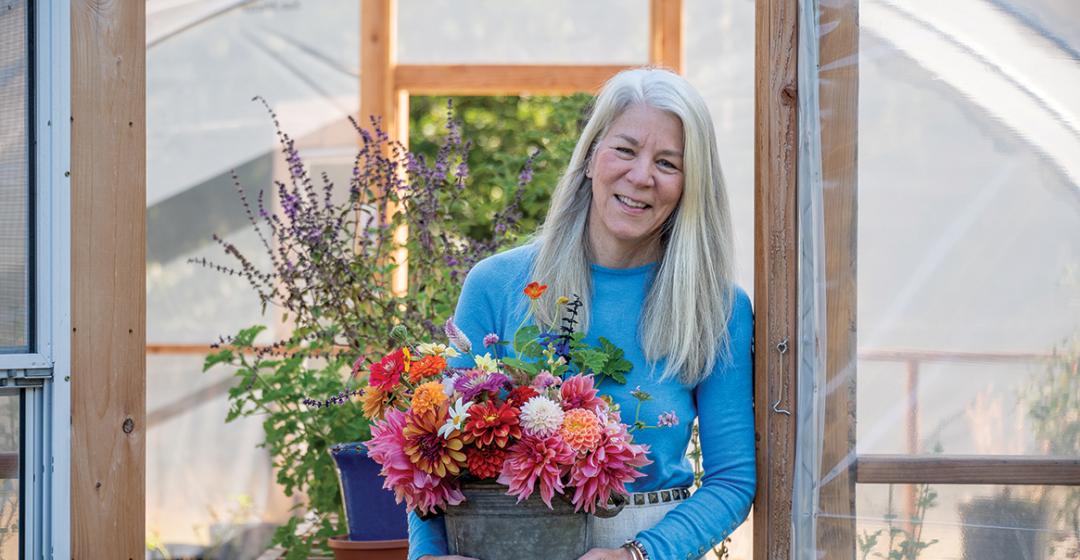


 2 comments
2 comments
Comments (2)